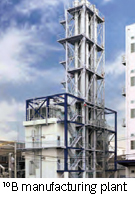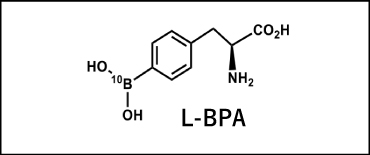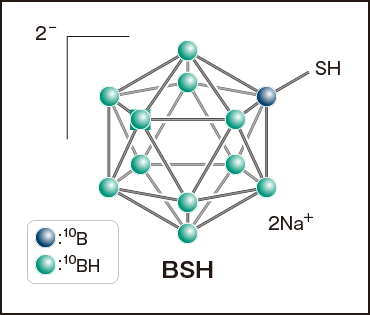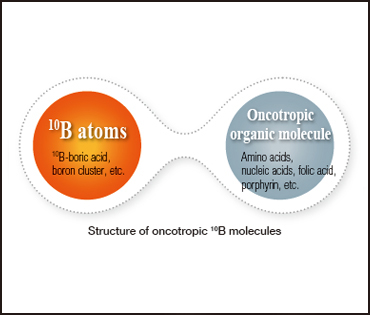Boron agents
Developing high-performance boron agents to selectively concentrate boron in tumor cells
Boron-10 and the manufacture of high-purity, enriched boron-10
 Boron is a chemical element with atomic number 5 in group 13 and period 2 of the periodic chart. Although it is common in the form of boric acid in rock, groundwater, surface water, and plants, it is not present in the human body. Natural boron exists in two isotopes with mass numbers of 10 (10B) and 11 (11B) in a proportion of about 1:4, and only 10B is capable of absorbing (capturing) thermal neutrons. Consequently, high-purity 10B (enriched 10B) is necessary as a raw material in order to manufacture the boron agents that are used in BNCT. Currently, only a small number of countries, including Japan and the U.S., have plants capable of manufacturing enriched 10B by sorting 10B and 11B in natural boron compounds and supplying it in large quantities.
Boron is a chemical element with atomic number 5 in group 13 and period 2 of the periodic chart. Although it is common in the form of boric acid in rock, groundwater, surface water, and plants, it is not present in the human body. Natural boron exists in two isotopes with mass numbers of 10 (10B) and 11 (11B) in a proportion of about 1:4, and only 10B is capable of absorbing (capturing) thermal neutrons. Consequently, high-purity 10B (enriched 10B) is necessary as a raw material in order to manufacture the boron agents that are used in BNCT. Currently, only a small number of countries, including Japan and the U.S., have plants capable of manufacturing enriched 10B by sorting 10B and 11B in natural boron compounds and supplying it in large quantities.
Pharmaceutical-grade boron compounds are manufactured using this enriched 10B in Japan, the Czech Republic, and other countries.
High-purity boron compounds for use in BNCT
【1】Properties required of 10B compounds and boron agents
Boron compounds for use in BNCT must exhibit the following principal properties:
they must accumulate selectively (the ratio of the concentration in tumor cells to the concentration in normal cells [T/N] must be greater than or equal to 3) and in large volumes (at a 10B concentration of 20 to 40 ppm), |
they must not have any pharmaceutical effects themselves and must function only as a boron delivery molecule (in this property, they differ substantially from normal drugs), |
they must not be metabolized but must instead remain in tumor tissue for a certain period of time, |
they must exhibit low toxicity since they are administered directly into the blood. |
Additionally, research to date has pointed to the importance of properties such as the balance of hydrophobic and hydrophilic tendencies and the proportion of each molecule’s chemical makeup accounted for by the element boron. Currently, two boron compounds are being used in clinical research into BNCT: BPA, which has the structure of an amino acid, and BSH, which has a cluster-like structure.
【2】L-BPA(L-p-Boronophenylalanine)
 L-BPA was initially used in BNCT for melanoma due to its similarity to L-phenylalanine, which is the substance from which melanin biosynthesis begins. Later, researchers realized that it has an exceptionally high propensity to accumulate in other tumors as well, and today it is used in BNCT for brain tumors and head and neck cancer. Additionally, because its high degree of hydrophobicity means that it almost never dissolves in water under neutral conditions, it is combined with a water-soluble substance such as D-fructose to form a water-soluble complex that is then used as a boron agent.
L-BPA was initially used in BNCT for melanoma due to its similarity to L-phenylalanine, which is the substance from which melanin biosynthesis begins. Later, researchers realized that it has an exceptionally high propensity to accumulate in other tumors as well, and today it is used in BNCT for brain tumors and head and neck cancer. Additionally, because its high degree of hydrophobicity means that it almost never dissolves in water under neutral conditions, it is combined with a water-soluble substance such as D-fructose to form a water-soluble complex that is then used as a boron agent.
【3】BSH (disodium mercaptoundecahydrododecaborate)
 Another boron compound that is used in clinical research is BSH, which consists of a series of boron clusters with a unique 20-facet structure. BSH, a water-soluble ionic molecule with 12 boron atoms, reacts efficiently with neutrons and, because it can pass through the blood-brain barrier, was initially used to treat brain tumors. While BSH’s tumor selectivity (T/N ratio) and propensity to accumulate inside cells are low, reports indicate that it has exhibits a tendency to be distributed in the vicinity of tumor tissue. Currently, combination treatments are being developed to take advantage of the respective advantages of BPA and BSH.
Another boron compound that is used in clinical research is BSH, which consists of a series of boron clusters with a unique 20-facet structure. BSH, a water-soluble ionic molecule with 12 boron atoms, reacts efficiently with neutrons and, because it can pass through the blood-brain barrier, was initially used to treat brain tumors. While BSH’s tumor selectivity (T/N ratio) and propensity to accumulate inside cells are low, reports indicate that it has exhibits a tendency to be distributed in the vicinity of tumor tissue. Currently, combination treatments are being developed to take advantage of the respective advantages of BPA and BSH.
【4】Trends in the development of new 10B compounds
 Reports in scientific literature detail the synthesis of various boron compounds with the goal of developing effective new boron compounds. Most consist of oncotropic molecules that have been modified with 10B. Drug delivery systems (DDSs) targeting the comparatively large gaps between capillaries that characterize tumor tissue are also under active development.
Reports in scientific literature detail the synthesis of various boron compounds with the goal of developing effective new boron compounds. Most consist of oncotropic molecules that have been modified with 10B. Drug delivery systems (DDSs) targeting the comparatively large gaps between capillaries that characterize tumor tissue are also under active development.